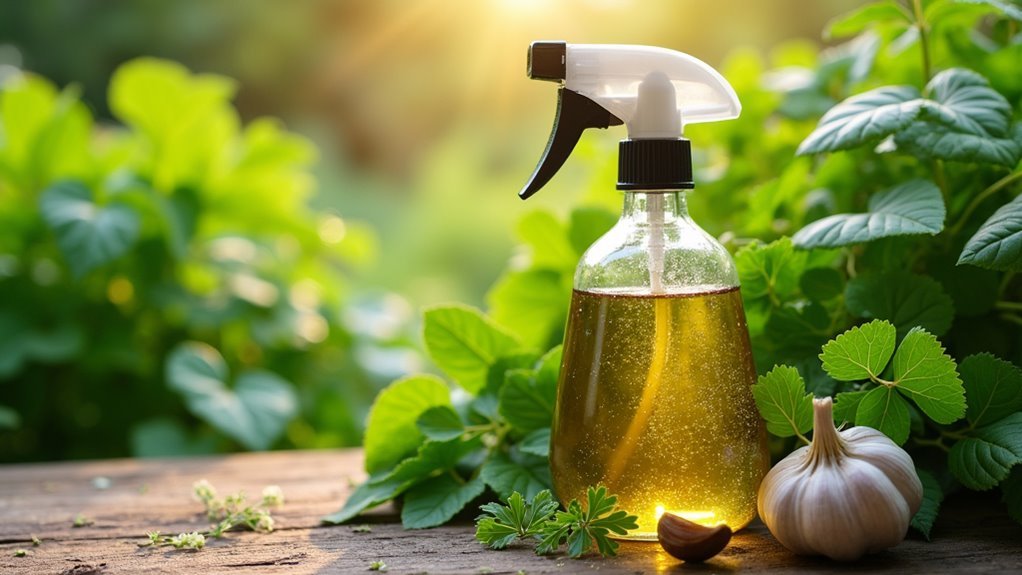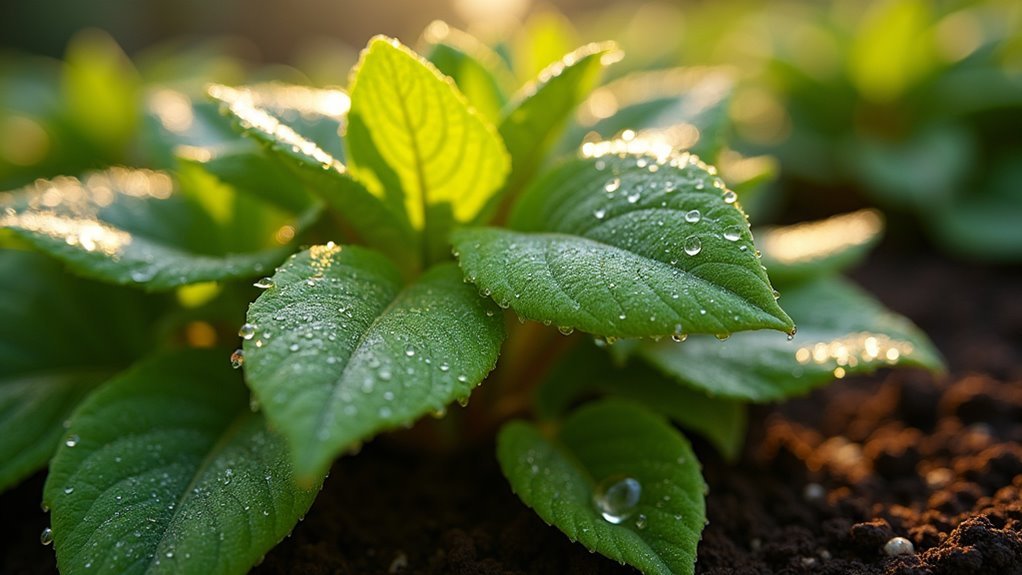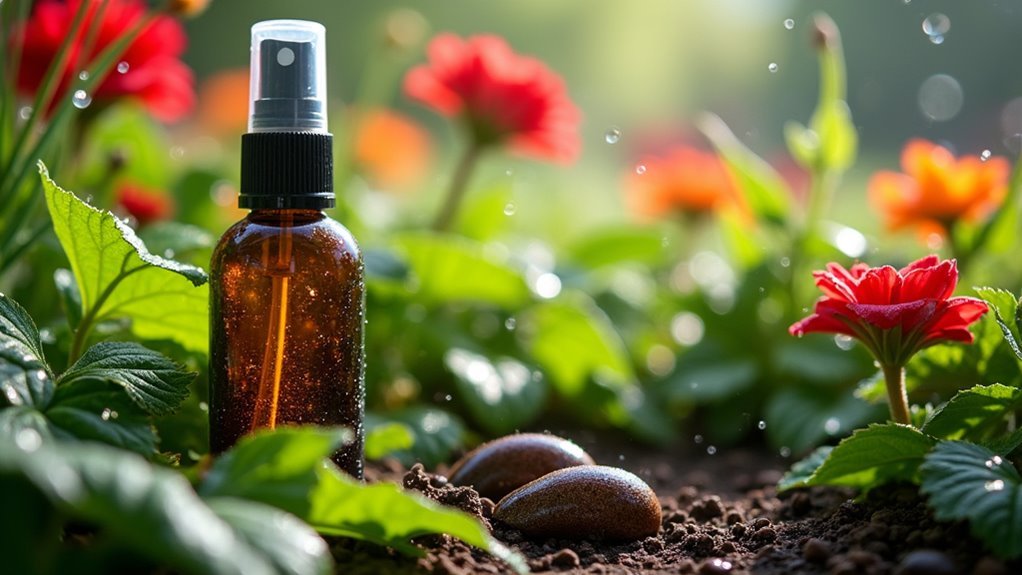You can create an effective organic slug deterrent by mixing 2 tablespoons of pure neem oil with 1 tablespoon of biodegradable dish soap in a gallon of water. Apply this natural spray during early morning or evening hours, thoroughly coating both leaf surfaces where slugs hide. The azadirachtin compound in neem oil disrupts slug feeding patterns and hormonal systems while remaining safe for edible crops. Proper application techniques and timing will maximize your garden’s protection.
Understanding Neem Oil as a Natural Slug Deterrent

Many gardeners struggle with slug damage, but neem oil offers a powerful, natural solution that disrupts these pests at the biological level. This naturally occurring extract from neem tree seeds contains azadirachtin, a compound that interferes with slug hormonal systems and feeding patterns.
Unlike harsh chemicals, neem oil works as an effective slug killer while remaining completely safe for your edible crops.
When you spray neem oil on affected areas, it creates a protective barrier that coats slugs and prevents them from reaching your plants. The compound doesn’t just repel—it actually disrupts their biological functions, making it impossible for them to feed normally.
This dual-action approach makes neem oil particularly effective for organic gardening, offering reliable pest control without chemical residues on your harvest.
Essential Ingredients for Organic Neem Oil Spray
When creating your own neem oil spray, you’ll need just three simple ingredients that work together to deliver maximum pest control effectiveness.
These basic components create a powerful organic solution that targets slugs and snails while protecting beneficial insects in your garden.
This organic pesticide formula effectively eliminates harmful slugs and snails while safely preserving helpful garden insects like bees and ladybugs.
- Pure neem oil – Use 2 tablespoons per gallon of water, ensuring you select cold-pressed, organic neem oil for maximum azadirachtin content.
- Clean water – One gallon serves as the base carrier for your spray mixture.
- Biodegradable dish soap – Add several drops to help emulsify the oil and improve application coverage.
- Optional spray bottle or garden sprayer – Essential for even distribution across affected areas.
The soap helps the neem oil mix properly with water, creating an effective barrier against garden pests.
Step-by-Step Recipe for Neem Oil Slug Repellent

You’ll need to gather your essential ingredients before mixing your neem oil slug repellent to guarantee proper pest control.
The correct mixing ratios are vital for creating an effective solution that won’t harm your plants while deterring slugs.
Proper application timing and techniques will maximize your spray’s effectiveness in protecting your garden.
Gathering Essential Ingredients
Creating an effective neem oil slug repellent starts with assembling three simple ingredients you likely already have on hand.
This gardening spray requires minimal preparation and proves highly effective against snails and slugs when properly mixed.
You’ll need these essential components:
- 2 tablespoons of neem oil – The active ingredient that deters slugs naturally
- 1 tablespoon of biodegradable dish soap – Acts as an emulsifier to blend oil and water
- 1 gallon of water – Dilutes the mixture for safe plant application
- A spray bottle – guarantees even distribution across affected areas
Quality matters when selecting your neem oil, so choose pure, cold-pressed varieties for maximum potency.
The biodegradable soap won’t harm beneficial insects while helping the solution adhere to plant surfaces effectively.
Proper Mixing Ratios
After collecting your ingredients, start by measuring exactly 2 tablespoons of neem oil into a clean mixing container.
Add 1 teaspoon of biodegradable dish soap to help emulsify the oil with water.
Pour in 1 quart of water and shake the mixture vigorously to guarantee proper mixing ratios are achieved.
The soap acts as an emulsifier, preventing the neem oil from separating from the water. This creates an effective, uniform solution that’ll coat plant surfaces evenly.
Before you apply the spray to your entire garden, test it on a small plant section first. This prevents potential damage to sensitive plants.
Once you’ve confirmed it’s safe, you can confidently apply the neem oil mixture to affected areas for slug control.
Application and Timing
Once your neem oil mixture is properly prepared, timing becomes essential for maximum effectiveness against slugs. Apply the solution during cooler periods when beneficial insects aren’t active and slugs are most vulnerable.
Follow these application guidelines:
- Schedule treatments for early morning or late evening when temperatures drop.
- Coat thoroughly by spraying both leaf tops and undersides where slugs hide.
- Reapply consistently every 7-14 days, especially after rainfall washes away the treatment.
- Monitor regularly for slug activity signs to adjust concentration and frequency.
You’ll need to observe your plants closely, noting any damage patterns or slime trails.
If slug pressure increases, don’t hesitate to apply neem oil more frequently or increase the concentration slightly for better protection.
Proper Application Techniques for Maximum Effectiveness

When applying organic oil sprays for slug control, timing plays an essential role in achieving maximum effectiveness while protecting beneficial insects.
Apply sprays early morning or late evening to minimize harm to bees while maximizing solution absorption. These proper application techniques guarantee your organic oil sprays deliver peak pest control results.
Timing your organic oil spray applications during early morning or late evening hours ensures maximum pest control effectiveness while protecting beneficial pollinators.
Focus on thorough coverage by spraying both leaf tops and undersides, where pests frequently hide.
Use a dilution ratio of 1-2 tablespoons biodegradable soap per gallon of water to control pests without damaging plants.
You’ll need to reapply after rainfall or heavy watering since moisture washes away the protective barrier.
Monitor your plants regularly for pest activity signs and adjust application frequency based on infestation levels to maintain your slug-free garden effectively.
Timing Your Neem Oil Treatments for Optimal Results
You’ll achieve the best results by timing your neem oil applications during cooler parts of the day – early morning or late evening – when temperatures stay below 90°F.
This strategic timing prevents leaf burn while maximizing the oil’s absorption into plant tissues where slugs feed.
You’ll also need to establish a consistent seasonal schedule that accounts for peak slug activity periods and weather patterns in your area.
Best Application Hours
Though neem oil proves highly effective against slugs and other garden pests, timing your application correctly can make the difference between success and disappointment.
What’s the best approach? Simply mix your neem oil solution and apply during ideal hours to maximize effectiveness while protecting your plants.
Follow these essential timing guidelines:
- Early morning applications – Spray before 8 AM when temperatures are cooler and direct sunlight won’t cause leaf burn.
- Evening treatments – Apply after 6 PM to protect beneficial insects like bees from exposure.
- Post-rain reapplication – Reapply after heavy watering or rainfall washes away the protective coating.
- Weather monitoring – Check conditions regularly to determine when pest activity peaks and treatments are most needed.
Cooler temperatures enhance absorption and improve overall pest control results.
Seasonal Treatment Schedule
Creating an effective seasonal treatment schedule guarantees your neem oil applications deliver maximum slug control throughout the year.
Start treatments at the beginning of the growing season as a preventative measure, before slugs establish themselves in your common garden areas. Apply neem oil every 7 to 14 days during active growing periods, following manufacturer’s dilution instructions carefully.
Monitor pest populations regularly and adjust frequency based on observed activity. You’ll want to increase applications during peak infestation periods when slugs are most active.
Rather than pay commercial pest control services, prefer pouring your resources into consistent neem oil treatments.
Avoid applications before rain or during extreme temperatures, which can stress plants and reduce effectiveness. This proactive approach maintains slug-free conditions throughout the season.
Combining Neem Oil With Other Natural Slug Control Methods
While neem oil provides solid slug deterrent properties on its own, combining it with other natural control methods creates a more robust defense system for your garden.
Layering neem oil with complementary natural methods amplifies your garden’s defense against slugs beyond what any single treatment can achieve.
You’ll achieve better results when you layer multiple strategies together.
Here’s how to maximize your slug control effectiveness:
- Mix neem oil with diatomaceous earth to create powerful barriers around vulnerable plants that disrupt slug movement and hormones simultaneously.
- Enhance neem oil with peppermint essential oil to boost repellent properties and make your garden less attractive to slugs.
- Install physical barriers like copper tape or crushed eggshells alongside neem oil treatments for thorough protection.
- Apply treatments during early morning or evening hours to protect beneficial insects while ensuring maximum absorption.
Remember to reapply after rain to maintain effectiveness.
Safety Considerations When Using Neem Oil in Gardens
Even though neem oil ranks among the safest natural pest control options, you’ll need to follow proper safety protocols to protect yourself, your plants, and beneficial garden wildlife.
Always wear gloves and a mask during application to prevent skin or respiratory irritation. Mix 1-2 tablespoons per gallon of water for effective results without harming your garden.
Apply neem oil during early morning or late evening hours to protect beneficial insects like bees, which are less active then. Avoid spraying during peak sun hours or hot days to prevent leaf burn.
Before widespread application, perform a patch test on a small plant area to guarantee no adverse reactions occur. These simple precautions guarantee safe, effective slug control.
Target Areas and Plants for Neem Oil Application
Once you’ve mastered the safety protocols, you’ll want to identify which areas of your garden will benefit most from neem oil treatment.
Strategic garden assessment ensures neem oil applications target the most vulnerable areas where pest problems typically develop and spread.
This versatile organic solution targets multiple pest species across various plant types, making it an invaluable tool for extensive garden protection.
Focus your neem oil applications on these key areas:
- Vegetable gardens – Essential for protecting crops from aphids and spider mites that damage leaves and reduce yields.
- Fruit trees and bushes – Prevents whitefly infestations that weaken plants and affect fruit quality.
- Ornamental plants – Maintains aesthetic appeal by controlling visible pest damage on flowers and foliage.
- Greenhouse environments – Creates controlled pest management in enclosed growing spaces.
Apply thoroughly to both leaf surfaces for maximum effectiveness against these common garden invaders.
Monitoring and Measuring Treatment Success
After implementing your neem oil treatment plan, you’ll need to establish a systematic monitoring approach to gauge its effectiveness against slug populations.
Start by regularly inspecting your plants for telltale signs like tiny holes in leaves and slime trails on surfaces. Count slugs before and after treatments using traps or direct observation to quantify population changes.
Keep a detailed treatment log recording application dates and weather conditions. This data helps you correlate successful outcomes with specific environmental factors.
Monitor your plants’ health by tracking growth rates and overall robustness—improved plant condition indicates effective pest management.
Reassess your strategy after each monitoring period, adjusting application frequency and methods based on slug population trends and treatment effectiveness.
Storage and Shelf Life of Homemade Neem Oil Solutions
Proper storage determines whether your homemade neem oil solution remains effective or becomes useless within days.
You’ll maximize your slug-fighting investment by following proper storage protocols that preserve the oil’s potency.
Here’s how to store your neem oil solution correctly:
- Use dark glass containers – Store in a cool, dark place away from direct sunlight and heat sources.
- Label with preparation date – Track freshness easily since solutions last only 2-3 weeks when stored properly.
- Add emulsifier like soap – Mix thoroughly to maintain solution integrity and prevent separation during storage.
- Monitor for degradation – Check regularly for separation or off odors indicating the solution has spoiled.
Exposure to light and heat rapidly reduces neem oil’s effectiveness, making proper storage essential for maintaining your garden’s slug defense system.
Frequently Asked Questions
How Do You Make Slug Spray for Garden?
You’ll mix 3-4 minced garlic cloves with 2 teaspoons mineral oil overnight. Strain, then combine with 1 pint water and 1 teaspoon biodegradable dish soap for effective slug control.
How Do You Make Organic Bug Spray for Vegetable Gardens?
You’ll combine 8 ounces of vegetable oil with 1 tablespoon of dish soap and 2 teaspoons of fragrant oil. This creates an effective organic pest control solution that’s safe for your vegetable garden.
Do Coffee Grounds Really Repel Slugs?
Yes, coffee grounds really do repel slugs through their caffeine content. You’ll create an effective barrier by sprinkling used grounds around plants, though you should combine this with other organic methods for best results.
What to Spray to Keep Slugs Away?
You can spray garlic oil solution, hot pepper spray, or soap spray directly on plants and slugs. Mix garlic with mineral oil and water, or combine hot sauce with dish soap for effective natural repellents.
In Summary
You’ve now got the tools to create an effective, eco-friendly slug control system using neem oil. Remember to apply your homemade spray consistently during peak slug activity hours, focusing on vulnerable plants and moist garden areas. Monitor your treated zones regularly and adjust application frequency based on weather conditions and slug pressure. With proper timing and technique, you’ll maintain a thriving, slug-free garden naturally without harmful chemicals.





Leave a Reply